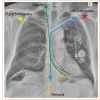Transvenous Lead Extraction: Work in Progress
- PMID: 37456768
- PMCID: PMC10345938
- DOI: 10.15420/ecr.2023.06
Transvenous Lead Extraction: Work in Progress
Abstract
Cardiac implantable electronic devices are the cornerstone of cardiac rhythm management, with a significant number of implantations annually. A rising prevalence of cardiac implantable electronic devices coupled with widening indications for device removal has fuelled a demand for transvenous lead extraction (TLE). With advancement of tools and techniques, the safety and efficacy profile of TLE has significantly improved since its inception. Despite these advances, TLE continues to carry risk of significant complications, including a superior vena cava injury and mortality. However, innovative approaches to lead extraction, including the use of the jugular and femoral accesses, offers potential for further gains in safety and efficacy. In this review, the indications and risks of TLE are discussed while examining the evolution of this procedure from simple traction to advanced methodologies, which have contributed to a significant improvement in safety and efficacy.
Keywords: ICD extraction; Transvenous lead extraction; femoral extraction; jugular pull-through; lead extraction; tandem approach.
Copyright © 2023, Radcliffe Cardiology.
Conflict of interest statement
Disclosure: MS has received a research grant from Abbott Medical. MMG has received research funding from Attune Medical, and has acted as a consultant and a paid speaker for Boston Scientific and Cook Medical; and is on the European Cardiology Review editorial board; this did not influence peer review. All other authors have no conflicts of interest to declare.
Figures





References
-
- National Institute for Cardiovascular Outcomes Research (NICOR). Am Heart J. https://www.nicor.org.uk/cardiac-rhythm-management-arrhythmia-audit/ (accessed 20 January 2023) - PubMed
-
- Starck CT, Gonzalez E, Al-Razzo O et al. Results of the Patient-Related Outcomes of Mechanical lead Extraction Techniques (PROMET) study: a multicentre retrospective study on advanced mechanical lead extraction techniques. Am Heart J. 2020;7:1103–10. doi: 10.1093/europace/euaa103. - DOI - PMC - PubMed
Publication types
LinkOut - more resources
Full Text Sources

